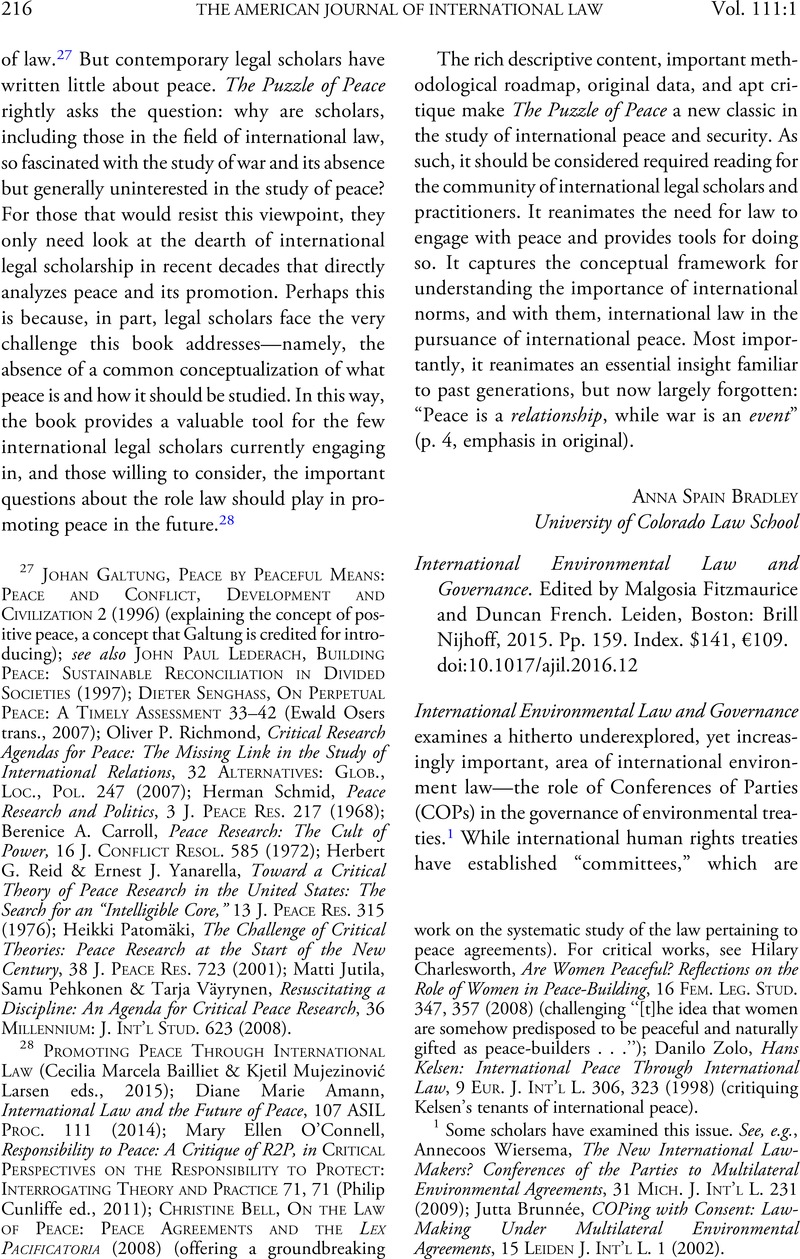No CrossRef data available.
Published online by Cambridge University Press: 12 April 2017

1 Some scholars have examined this issue. See, e.g., Wiersema, Annecoos, The New International Law-Makers? Conferences of the Parties to Multilateral Environmental Agreements, 31 Mich. J. Int'l L. 231 (2009)Google Scholar; Brunnée, Jutta, COPing with Consent: Law-Making Under Multilateral Environmental Agreements , 15 Leiden J. Int'l L. 1 (2002)Google Scholar.
2 Currently, there are ten treaty bodies, details are available here: http://www.ohchr.org/EN/HRBodies/Pages/TreatyBodies.aspx. See also Mechlem, Kerstin, Treaty Bodies and the Interpretation of Human Rights, 42 Vand. J. Transnat'l L. 905 (2009)Google Scholar.
3 See Promoting Compliance in an Evolving Climate Regime (Jutta Brunnée, Meinhard Doelle & Lavanya Rajamani eds., 2012).
4 See de Silva, Lalanath, Public Participation in International Negotiation and Compliance, in International Environmental Law and the Global South 572 (Alam, Shawkat, Atapattu, Sumudu, Gonzalez, Carmen G. & Razzaque, Jona eds., 2015)CrossRefGoogle Scholar.
5 See Sumudu Atapattu & Carmen G. Gonzalez, The North-South Divide in International Environmental Law: Framing the Issues, in International Environmental Law and the Global South, supra note 4, at 1–12.
6 David Hunter, James Salzman & Durwood Zaelke, International Environmental Law and Policy 669 (5th ed. 2015).
7 NRDC v. EPA, 464 F.3d 1, 10 (D.C. Cir. 2006), quoted in CAN Ad-Hoc Legal Working Group, COP Decisions: Binding or Not, Climate Action Network Int'l (June 8, 2009), at http://www.climatenetwork.org/sites/default/files/COP_Decisions_CAN_legal_group_June_8_09.pdf.
8 Vienna Convention on Law of Treaties, Art. 31(3)(c), May 23, 1969, 1555 UNTS 331.
9 Supra note 1.
10 Brunnée, supra note 1.
11 Several funds have been established under the UNFCCC—the adaptation fund, the least developed country fund, and green climate fund are examples. See UNFCCC, List of Recent Climate Funding Announcements, at http://newsroom.unfccc.int/financial-flows/list-of-recent-climate-funding-announcements.
12 The Warsaw International Mechanism for Loss and Damage was adopted at COP19 and was incorporated into the Paris Agreement in 2015. See UNFCCC, Warsaw International Mechanism for Loss and Damage Associated with Climate Change Impacts, at http://unfccc.int/adaptation/workstreams/loss_and_damage/items/8134.php.
13 Women and Gender Constituency was launched in 2009 and the Lima Work Program on Gender was launched at COP20 in Lima. See Sumudu Atapattu, Human Rights Approaches to Climate Change: Challenges and Opportunities ch. 8 (2015).
14 Id., ch. 7.
15 See de Silva, supra note 4.
16 See Int'l Law Comm'n, Fragmentation of International Law: Difficulties Arising from the Diversification and Expansion of International Law, UN Doc. A/CN.4/L.682 (Apr. 13, 2006), at http://legal.un.org/ilc/documentation/english/a_cn4_l682.pdf.